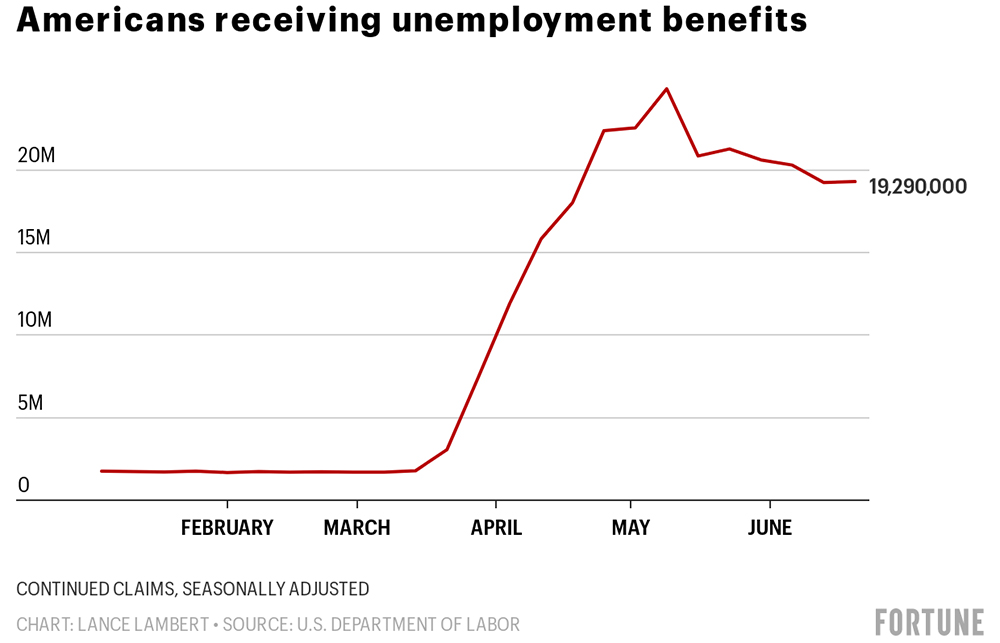美国劳工部公布的数据显示,截至6月20日的一周内,美国目前申领失业补助金或持续申领失业补助的总人数为1,930万人。
美国失业人数从5月9日的最高峰2,490万人,减少了560万人。这体现了自5月和6月各地纷纷解封以来美国经济和就业的复苏程度。
申领本州失业补助的美国人,目前每周可以从联邦政府额外获得600美元的失业补助金。但《冠状病毒援助、救济和经济安全法案》(CARES Act)中额外提供的每周600美元(每月2,400美元)补助,将在7月底到期,除非联邦政府延期。

参议院的共和党人反对把600美元的额外补助延长到7月以后,主要原因是他们认为这种慷慨的福利不利于激励失业者重新回到工作岗位。延长失业保险将让十分之七的美国失业者增加收入。
但在该补助到期之前,有560万失业者重新找到了工作,反驳了这种观点。
上周,许多经济学家告诉《财富》杂志,他们认为600美元的额外补助到期,可能会导致美国经济复苏脱离正轨。失业者每周的收入减少600美元,会迫使他们减少消费,从而降低整体消费者支出,而消费者支出占美国GDP的三分之二。
我们了解到截至6月27日,美国单周首次申领失业补助金的人数增加了140万人,已经连续14周超过100万人。然而,在600美元额外补助到期之前,这些最近失业的美国人只有几周时间能享受这项福利。(财富中文网)
译者:Biz
美国劳工部公布的数据显示,截至6月20日的一周内,美国目前申领失业补助金或持续申领失业补助的总人数为1,930万人。
美国失业人数从5月9日的最高峰2,490万人,减少了560万人。这体现了自5月和6月各地纷纷解封以来美国经济和就业的复苏程度。
申领本州失业补助的美国人,目前每周可以从联邦政府额外获得600美元的失业补助金。但《冠状病毒援助、救济和经济安全法案》(CARES Act)中额外提供的每周600美元(每月2,400美元)补助,将在7月底到期,除非联邦政府延期。
美国申领失业补助金的总人数
参议院的共和党人反对把600美元的额外补助延长到7月以后,主要原因是他们认为这种慷慨的福利不利于激励失业者重新回到工作岗位。延长失业保险将让十分之七的美国失业者增加收入。
但在该补助到期之前,有560万失业者重新找到了工作,反驳了这种观点。
上周,许多经济学家告诉《财富》杂志,他们认为600美元的额外补助到期,可能会导致美国经济复苏脱离正轨。失业者每周的收入减少600美元,会迫使他们减少消费,从而降低整体消费者支出,而消费者支出占美国GDP的三分之二。
我们了解到截至6月27日,美国单周首次申领失业补助金的人数增加了140万人,已经连续14周超过100万人。然而,在600美元额外补助到期之前,这些最近失业的美国人只有几周时间能享受这项福利。(财富中文网)
译者:Biz
The total number of Americans currently receiving unemployment benefits—called 'continued claims'—came in at 19.3 million in the week ending June 20, according to data published last Thursday by the U.S. Department of Labor.
The number of Americans on the unemployment rolls is down 5.6 million from its 24.9 million peak on May 9. This speaks to how much the economy and employment have recovered since states eased lockdowns in May and June.
Americans on state unemployment rolls are currently receiving an extra $600 per week in unemployment benefits from the federal government on top of their state benefits. However, that extra $600 per week—or $2,400 per month—from the CARES Act expires at the end of July unless extended by the federal government.
The main reason Senate Republicans are opposed to extending the extra $600 per week past July is they're worried that the generosity of the benefit is a disincentive to returning to work. Around 7 in 10 jobless Americans saw a pay increase by going on unemployment insurance.
Yet the fact that 5.6 million Americans have returned to work and fallen off the unemployment rolls before the benefit expires, does challenge that argument.
A few economists have told Fortune last week they think the expiration of the extra $600 benefit could derail the economic recovery. Taking away $600 per week from unemployed Americans could cause them to spend less, and decrease overall consumer spending—which accounts for 2/3 of GDP.
And on Thursday we learned another 1.4 million initial unemployment claims were filed in the week ending June 27. That marks 14 straight weeks with claims topping one million. However, these recent jobless Americans will only have a few weeks of the extra $600 federal benefit before it expires.






